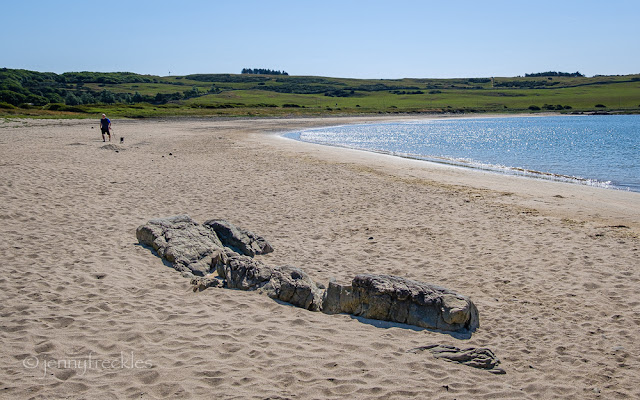Dumfries and Galloway holiday 2
Not far from the WWT reserve, there's a very old castle called Caerlaverock. The ruin, in the charge of Historic Scotland, is now closed to visitors due to fears about the safety of the masonry but you can wander in the grounds.
By this stage, mid-afternoon, it was so very hot and humid that I was relieved that the tiny café in the grounds was open and I could buy cold drinks and ice cream to cool off a bit. I couldn't be bothered to walk far and I was a bit brain-dead (!) so I didn't even take many photos. You can see from the pictures how parched our land is after a month or so with hardly any rain; the grass looked more like it usually does at the end of a dry summer, not the beginning!

The triangular castle sits deep in a moat, attractively surrounded by water, reeds and yellow iris, with a bridge across to its gate. It dates back to the 1270s, and was built by the Maxwells, a prominent dynastic family in the area. It was besieged in the 1300s during the wars of independence and, though the sixty men in the garrison withstood the onslaught for a while, in the end they were forced to surrender to the much larger English army. It was eventually restored to the Maxwell family and subsequently underwent several other sieges and battles; the Scottish Borders area was always in flux.
In the1630s, a new lodging was built inside the walls for Robert, the 10th Lord Maxwell and his wife, Elizabeth Beaumont. You can see the Jacobean frontage, with its regular window openings and Renaissance decoration, in the picture below, very different architecture from the rest of the medieval castle inside which it sits. The family were staunch Catholics and very soon a Protestant Covenanter army besieged the castle and forced its surrender. The south wall and tower were demolished and the castle was never occupied again.
On land behind the castle there is evidence of an even older structure (below), one of the earliest stone castles in Scotland, built in the 1230s but then abandoned in favour of the newer castle, which stands on higher ground.
It's interesting to speculate on the lives that people led in those very early times, which were as full of turmoil 'politically' as our current world is and must have felt quite precarious, when opposing factions could muster large armies and wars were commonplace. At least if Scotland decides to turn independent in the future, we're a lot less likely to send troops north! You'll more probably find a film crew in the castle than an army these days.
And finally, a sneaky pic of me enjoying my ice cream in the little café at Caerlaverock!



















































